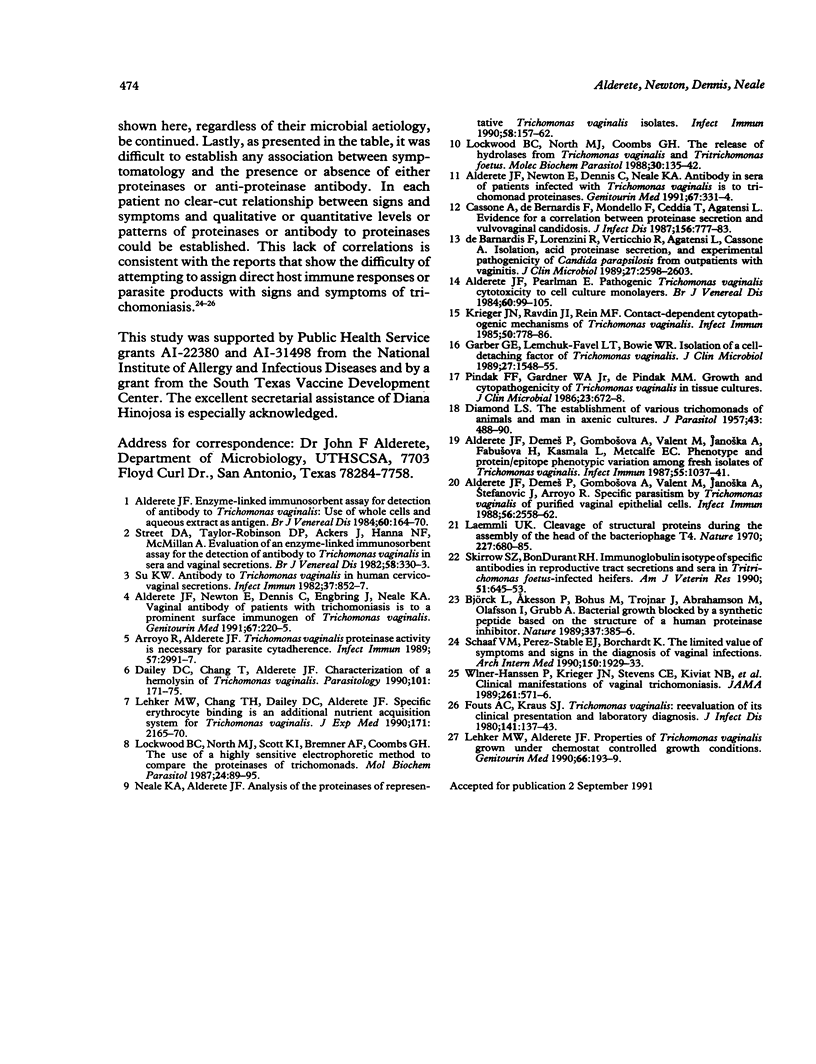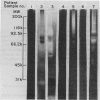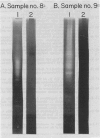Abstract
BACKGROUND--Patients with trichomoniasis have serum antibody to numerous T. vaginalis cysteine proteinases, indicating that the proteinases are expressed in vivo. It was important, therefore, to examine for the presence of soluble trichomonad proteinases and/or antibody to the proteinases in the vagina of infected women. METHODS--Vaginal washes (VWs) from 20 women were examined for the presence of proteinases by electrophoresis using acrylamide co-polymerised with gelatin as the indicator system. Antibody to proteinases in VWs was detected by an immunoprecipitation assay involving protein A-bearing Staphylococcus aureus first coated with anti-human immunoglobulin G (IgG) antibody, which was then added to VWs. For VWs having soluble proteinases, the bacteria were used to determine whether immune complexes between antibody and proteinases were present. VWs without soluble proteinases were incubated with the anti-human IgG treated bacteria before adding to detergent extracts of T. vaginalis. Individual isolates from the patients examined in this study were also analysed by one- and two-dimensional electrophoresis for their proteinase content. Finally, VWs were from patients without any history of other sexually transmitted diseases (STDs) as well as from individuals having numerous other STDs, including yeast, group B streptococcus, chlamydia, and syphilis. RESULTS--Approximately one-third of patients had soluble proteinases in the VWs; the remaining two-thirds (70%) of patients and normal women had no detectable proteinases in VWs. Half of the patients without soluble proteinases had IgG which, when bound to S. aureus, immunoprecipitated many proteinases from a detergent extract of T. vaginalis. All soluble proteinases and those precipitated from trichomonal extracts were inhibited by inhibitors of cysteine proteinases. Finally, patients having trichomoniasis in addition to numerous other STD agents, including yeast, group B streptococcus, chlamydia, and syphilis did not have soluble proteinases in VWs. Equally noteworthy, some patients with soluble proteinases in VWs did not have other detectable STD agents. CONCLUSIONS--Proteinases were detected in the vagina of some patients with trichomoniasis, and in most cases the proteinases were complexed with IgG, which was precipitated by S. aureus. Patients without soluble proteinases in VWs also had antibody specifically to trichomonad proteinases, again demonstrating both the expression and immunogenic nature of the proteinases in vivo. The absence of soluble proteinases in normal women and in patients having other STD agents as well as the presence of proteinases in VWs of patients without other detectable STD pathogens reinforced the idea that the proteinases were of T. vaginalis parasite origin. The findings of this study indicate that proteinases may be important to the T. vaginalis-host interrelationship.
Full text
PDF





Images in this article
Selected References
These references are in PubMed. This may not be the complete list of references from this article.
- Alderete J. F., Demes P., Gombosová A., Valent M., Yánoska A., Fabusová H., Kasmala L., Garza G. E., Metcalfe E. C. Phenotypes and protein-epitope phenotypic variation among fresh isolates of Trichomonas vaginalis. Infect Immun. 1987 May;55(5):1037–1041. doi: 10.1128/iai.55.5.1037-1041.1987. [DOI] [PMC free article] [PubMed] [Google Scholar]
- Alderete J. F., Demeś P., Gombosova A., Valent M., Fabusová M., Jánoska A., Stefanovic J., Arroyo R. Specific parasitism of purified vaginal epithelial cells by Trichomonas vaginalis. Infect Immun. 1988 Oct;56(10):2558–2562. doi: 10.1128/iai.56.10.2558-2562.1988. [DOI] [PMC free article] [PubMed] [Google Scholar]
- Alderete J. F. Enzyme linked immunosorbent assay for detecting antibody to Trichomonas vaginalis: use of whole cells and aqueous extract as antigen. Br J Vener Dis. 1984 Jun;60(3):164–170. doi: 10.1136/sti.60.3.164. [DOI] [PMC free article] [PubMed] [Google Scholar]
- Alderete J. F., Newton E., Dennis C., Engbring J., Neale K. A. Vaginal antibody of patients with trichomoniasis is to a prominent surface immunogen of Trichomonas vaginalis. Genitourin Med. 1991 Jun;67(3):220–225. doi: 10.1136/sti.67.3.220. [DOI] [PMC free article] [PubMed] [Google Scholar]
- Alderete J. F., Newton E., Dennis C., Neale K. A. Antibody in sera of patients infected with Trichomonas vaginalis is to trichomonad proteinases. Genitourin Med. 1991 Aug;67(4):331–334. doi: 10.1136/sti.67.4.331. [DOI] [PMC free article] [PubMed] [Google Scholar]
- Alderete J. F., Pearlman E. Pathogenic Trichomonas vaginalis cytotoxicity to cell culture monolayers. Br J Vener Dis. 1984 Apr;60(2):99–105. doi: 10.1136/sti.60.2.99. [DOI] [PMC free article] [PubMed] [Google Scholar]
- Arroyo R., Alderete J. F. Trichomonas vaginalis surface proteinase activity is necessary for parasite adherence to epithelial cells. Infect Immun. 1989 Oct;57(10):2991–2997. doi: 10.1128/iai.57.10.2991-2997.1989. [DOI] [PMC free article] [PubMed] [Google Scholar]
- Björck L., Akesson P., Bohus M., Trojnar J., Abrahamson M., Olafsson I., Grubb A. Bacterial growth blocked by a synthetic peptide based on the structure of a human proteinase inhibitor. Nature. 1989 Jan 26;337(6205):385–386. doi: 10.1038/337385a0. [DOI] [PubMed] [Google Scholar]
- Cassone A., De Bernardis F., Mondello F., Ceddia T., Agatensi L. Evidence for a correlation between proteinase secretion and vulvovaginal candidosis. J Infect Dis. 1987 Nov;156(5):777–783. doi: 10.1093/infdis/156.5.777. [DOI] [PubMed] [Google Scholar]
- DIAMOND L. S. The establishment of various trichomonads of animals and man in axenic cultures. J Parasitol. 1957 Aug;43(4):488–490. [PubMed] [Google Scholar]
- Dailey D. C., Chang T. H., Alderete J. F. Characterization of Trichomonas vaginalis haemolysis. Parasitology. 1990 Oct;101(Pt 2):171–175. doi: 10.1017/s0031182000063204. [DOI] [PubMed] [Google Scholar]
- De Bernardis F., Lorenzini R., Verticchio R., Agatensi L., Cassone A. Isolation, acid proteinase secretion, and experimental pathogenicity of Candida parapsilosis from outpatients with vaginitis. J Clin Microbiol. 1989 Nov;27(11):2598–2603. doi: 10.1128/jcm.27.11.2598-2603.1989. [DOI] [PMC free article] [PubMed] [Google Scholar]
- Fouts A. C., Kraus S. J. Trichomonas vaginalis: reevaluation of its clinical presentation and laboratory diagnosis. J Infect Dis. 1980 Feb;141(2):137–143. doi: 10.1093/infdis/141.2.137. [DOI] [PubMed] [Google Scholar]
- Garber G. E., Lemchuk-Favel L. T., Bowie W. R. Isolation of a cell-detaching factor of Trichomonas vaginalis. J Clin Microbiol. 1989 Jul;27(7):1548–1553. doi: 10.1128/jcm.27.7.1548-1553.1989. [DOI] [PMC free article] [PubMed] [Google Scholar]
- Krieger J. N., Ravdin J. I., Rein M. F. Contact-dependent cytopathogenic mechanisms of Trichomonas vaginalis. Infect Immun. 1985 Dec;50(3):778–786. doi: 10.1128/iai.50.3.778-786.1985. [DOI] [PMC free article] [PubMed] [Google Scholar]
- Laemmli U. K. Cleavage of structural proteins during the assembly of the head of bacteriophage T4. Nature. 1970 Aug 15;227(5259):680–685. doi: 10.1038/227680a0. [DOI] [PubMed] [Google Scholar]
- Lehker M. W., Alderete J. F. Properties of Trichomonas vaginalis grown under chemostat controlled growth conditions. Genitourin Med. 1990 Jun;66(3):193–199. doi: 10.1136/sti.66.3.193. [DOI] [PMC free article] [PubMed] [Google Scholar]
- Lehker M. W., Chang T. H., Dailey D. C., Alderete J. F. Specific erythrocyte binding is an additional nutrient acquisition system for Trichomonas vaginalis. J Exp Med. 1990 Jun 1;171(6):2165–2170. doi: 10.1084/jem.171.6.2165. [DOI] [PMC free article] [PubMed] [Google Scholar]
- Lockwood B. C., North M. J., Coombs G. H. The release of hydrolases from Trichomonas vaginalis and Tritrichomonas foetus. Mol Biochem Parasitol. 1988 Aug;30(2):135–142. doi: 10.1016/0166-6851(88)90106-5. [DOI] [PubMed] [Google Scholar]
- Lockwood B. C., North M. J., Scott K. I., Bremner A. F., Coombs G. H. The use of a highly sensitive electrophoretic method to compare the proteinases of trichomonads. Mol Biochem Parasitol. 1987 May;24(1):89–95. doi: 10.1016/0166-6851(87)90119-8. [DOI] [PubMed] [Google Scholar]
- Neale K. A., Alderete J. F. Analysis of the proteinases of representative Trichomonas vaginalis isolates. Infect Immun. 1990 Jan;58(1):157–162. doi: 10.1128/iai.58.1.157-162.1990. [DOI] [PMC free article] [PubMed] [Google Scholar]
- Pindak F. F., Gardner W. A., Jr, Mora de Pindak M. Growth and cytopathogenicity of Trichomonas vaginalis in tissue cultures. J Clin Microbiol. 1986 Apr;23(4):672–678. doi: 10.1128/jcm.23.4.672-678.1986. [DOI] [PMC free article] [PubMed] [Google Scholar]
- Schaaf V. M., Perez-Stable E. J., Borchardt K. The limited value of symptoms and signs in the diagnosis of vaginal infections. Arch Intern Med. 1990 Sep;150(9):1929–1933. [PubMed] [Google Scholar]
- Skirrow S. Z., BonDurant R. H. Immunoglobulin isotype of specific antibodies in reproductive tract secretions and sera in Tritrichomonas foetus-infected heifers. Am J Vet Res. 1990 Apr;51(4):645–653. [PubMed] [Google Scholar]
- Street D. A., Taylor-Robinson D., Ackers J. P., Hanna N. F., McMillan A. Evaluation of an enzyme-linked immunosorbent assay for the detection of antibody to Trichomonas vaginalis in sera and vaginal secretions. Br J Vener Dis. 1982 Oct;58(5):330–333. doi: 10.1136/sti.58.5.330. [DOI] [PMC free article] [PubMed] [Google Scholar]
- Su K. E. Antibody to Trichomonas vaginalis in human cervicovaginal secretions. Infect Immun. 1982 Sep;37(3):852–857. doi: 10.1128/iai.37.3.852-857.1982. [DOI] [PMC free article] [PubMed] [Google Scholar]
- Wølner-Hanssen P., Krieger J. N., Stevens C. E., Kiviat N. B., Koutsky L., Critchlow C., DeRouen T., Hillier S., Holmes K. K. Clinical manifestations of vaginal trichomoniasis. JAMA. 1989 Jan 27;261(4):571–576. doi: 10.1001/jama.1989.03420040109029. [DOI] [PubMed] [Google Scholar]





